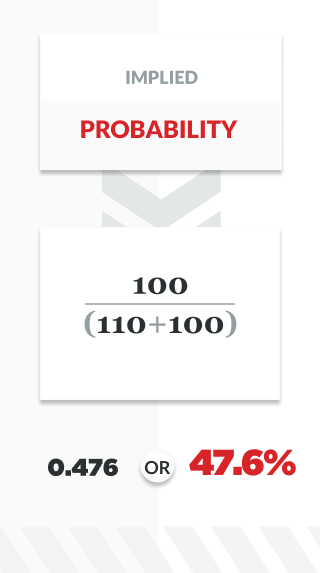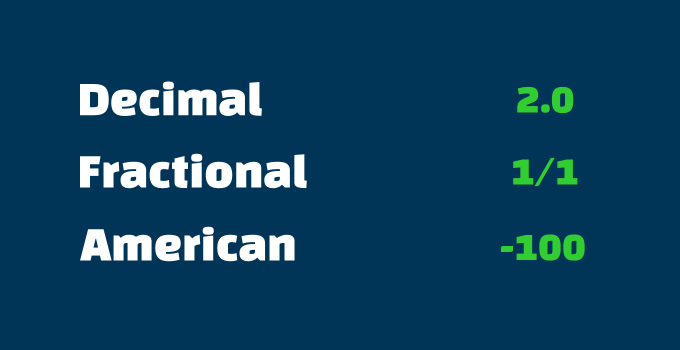How Are Odds Calculated In Sports

The Expected Value of a bet shows us how much we can expect to win (on average) per bet, and as such is the most valuable calculation a bettor can make when comparing bookmakers odds. How can you calculate Expected Value in sports betting in order to predict your winnings? Read on to find out.
These odds suggest that if this fight happened 21 times (8 + 13), Golovkin would lose 8 bouts and win 13. To calculate the implied probability of Golovkin winning the fight, take the number of times he is expected to win (13) and divide it by the total number of trials (21). This results in a 61.9% chance Golovkin will win the fight. To calculate your winnings with decimal odds you just multiply your stake by the odds. 9/2 in decimal odds is 5.50, so in the example above £10 x 5.50 gives £55. To convert from fraction/ratio odds to decimal just divide the first number by the second and add 1.
Expected Value
The amount a player can expect to win or lose if they were to place a bet on the same odds many times over, calculated through a simple equation multiplying your probability of winning with the amount you could win per bet, and subtracting the probability of losing multiplied by the amount lost per bet.
A simple example of Expected Value (EV) put into practice - if you were to bet $10 on heads in a coin toss, and you were to receive $11 every time you got it right, the EV would be 0.5.
This means that if you were to make the same bet on heads over and over again, you can expect to win an average of $0.50 for each bet of $10.
How to Calculate Expected Value
The formula for calculating Expected Value is relatively easy – simply multiply your probability of winning with the amount you could win per bet, and subtract the probability of losing multiplied by the amount lost per bet:
(Probability of Winning) x (Amount Won per Bet) – (Probability of Losing) x (Amount Lost per Bet)
To calculate the expected value for sports betting, you can fill in the above formula with decimals odds with a few calculations:
Odds Calculator And Payout American Odds
- Find the decimal odds for each outcome (win, lose, draw)
- Calculate the potential winnings for each outcome by multiplying your stake by the decimal, and then subtract the stake.
- Divide 1 by the odds of an outcome to calculate the probability of that outcome
- Substitute this information into the above formula.
For example, when Manchester United (1.263) play Wigan (13.500), with a draw at 6.500, a bet of $10 on Wigan to win would provide potential winnings of $125, with the probability of that happening at 0.074 or 7.4%.
The probability of this outcome not occurring is the sum of Man Utd and a draw, or 0.792 + 0.154 = 0.946. The amount lost per bet is the initial wager – $10. Therefore the complete formula looks like:
The EV is negative for this bet, suggesting that you will lose an average of $0.20 for every $10 staked.
How Are Odds Calculated In Sports Betting
How Does Expected Value for Sports Betting Help?

Remember, a negative EV doesn’t mean you’re going to lose money. Unlike a coin toss, sports betting odds are subjective, and therefore if you outsmart the bookmaker, you’re likely to make money.
If you calculate your own probability for a match that differs from the implied probability of the odds, you could see where to find a positive EV, and therefore the best chance to win.
For example, the odds imply that Wigan only have a 7.4% chance of winning. If you calculate (maybe using a system like Poisson distribution) that Wigan has a 10% chance of winning, the EV for betting on a Wigan win jumps to $3.262.
It’s also a perfect measure for comparing odds in arbitrage betting, which is discussed in our article What is arbitrage betting.
Calculating the EV of bets gives bettors more information about the value of their bookmaker. While low-margin bookmakers like Pinnacle have EVs of around -$0.20, it’s not uncommon for typical bookmakers to have an EV of -$1.00 – for every $10 stake you would be likely to lose a $1 .
How bookmakers make money video explainer
Found this article useful? Why not check out our video that details how to find value.
If you want to watch more educational betting videos, subscribe to the Pinnacle YouTube channel!


I’ve been reading a lot of books about sports analytics lately. My current read is The Logic of Sports Betting by Ed Miller and Matthew Davidow. One of the first concepts discussed in the book is understanding the balanced hold of a sportsbook on a two-way market. In a two-way market, you take either one side of a bet or the other, for example Team A will win, or Team B will. The hold is simply the profit a book “holds” onto after all of the winning bets have been paid, divided by the total wagers placed. A balanced hold assumes (naively) that the book is holding balanced action on the wagers, meaning that no matter which side wins, the book will have the same amount of profit. This is rarely realty for a number of reasons. However, the concept is emphasized as important, presumably because it will be needed for later concepts. While a couple of contrived examples are presented, the how of to calculate the balanced hold is not spelled out—at least in the chapters I’ve read thus far.
I wanted to be able to quickly calculate the hold myself, so I tried a few unsuccessful Google searches. So in about 15 minutes I figured out how to calculate it myself, first via doing the math on paper, then building a spreadsheet calculator to make it easier to calculate on the fly as needed.
Here’s some examples laid out in the book in American Odds:
| Example 1 | Team A | Team B |
|---|---|---|
| Odds | -150 | +130 |
| Wagers Placed | $150.00 | $108.69 |
| Potential Payout | $100.00 | $141.30 |
| Potential Profit(Losing Wager Kept minus Winning Bet Payed Out) | $8.69 | $8.70 |
| Balanced Hold(Payout divided by total wagers taken) | 3.4% | 3.4% |
The last part, calculating the hold percentage is the easiest: you just divide the profit by total money wagered. The harder part is to figure out what the profit and amount wagered need to be in order for the action to be balanced. For that to happen, we need to have the amount paid to each possible winner subtracted from the amount wagered by the respective loser to be equal. For example 1 that looks like:
Profit from Team A winning = Wagers placed on Team B minus payout on Team A wagers = $108.69 - $100.00 = $8.69
How Do You Calculate Odds In Sports Betting
Profit from Team B winning = Wagers placed on Team A minus payout on Team B wagers = $150.00 - $141.30 = $8.70
Profit from Team A winning = Profit from Team B winning
The way I tackled this problem was to start with calculating the wager to payout ratio for each bet. Since we’ll need to be calculating both the wager and payout amounts, we need this ratio to solve later variables. I won’t go into how dumb American odds are, but a quick overview of what they represent. If a wager’s odds are negative (-150), that means you have to risk $150 to win $100. If a wager’s odds are positive (+130), then if you wager $100 you will receive the odds ($130) back. Therefore, in example 1, the ratio of wager to payout for each bet is:

| Example 1 | Team A | Team B |
|---|---|---|
| Odds | -150 | +130 |
| Wagers Placed | $150.00 | $100.00 |
| Potential Payout | $100.00 | $130.00 |
| Payout-to-Wager Ratio | 0.667 | 1.3 |
You can do this in a spreadsheet formula would look something like this:
In order to solve the problem, I started by assigning an arbitrary wager and payout for one side of the bet. In this case, I just set side A with potential payout of $100, so risking $150. If it was a plus bet, I’d set it to risk $100 and payout to the odds. The formula for the risk would look like:
Then for the payout you would just multiply your risk to the ratio calculated above.
| Example 1 | Team A | Team B |
|---|---|---|
| Odds | -150 | +130 |
| Wagers Placed | $150.00 | X |
| Potential Payout | $100.00 | Y |
| Payout-to-Wager Ratio | 0.667 | 1.3 |
| Potential Profit | $? | $? |
| Balanced Hold | ?% | ?% |
Since our objective is to have the profit for both columns to be equal, we can setup the equation like this:
Since previously calculated the ratio between X and Y, we can replace Y with a factor of X:
Now we can solve for X:
Let’s plug in these new values for wagers and payouts on Team B, and calculate the profit on each outcome:
| Example 1 | Team A | Team B |
|---|---|---|
| Odds | -150 | +130 |
| Wagers Placed | $150.00 | $108.70 |
| Potential Payout | $100.00 | $141.30 |
| Payout-to-Wager Ratio | 0.667 | 1.3 |
| Potential Profit | $8.70 | $8.70 |
| Balanced Hold | 3.4% | 3.4% |
Success! If you aren’t interested in recreating this yourself, you can just grab a copy of my Balanced Sportsbook Hold Calculator Google Sheet.
Multi-way Markets
I was feeling super proud of myself until I got to the next chapter, which spelled out how it’s equally important, but much harder, to calculate a multi-way market. A two-way market takes the form of
- Who will win the 2019 NBA Playoffs?
- Toronto Raptors
- Golden State Warriors
- Or How many games will the 2019 Boston Red Sox win?
- More than (Over) 94.5
- Fewer than (Under) 94.5
A multi-way market has more than two options. Such as:
- Result of 2019 Women’s World Cup Match between USA and Thailand:
- USA wins
- Thailand wins
- Tie
- Or Who will win the 2019 Women’s World Cup (24 options):
- France
- USA
- Germany
- England
- Netherlands
- Australia
- et c.
Odds Calculator Payout
After much more scratchpad/Google Sheet math, I realized that for each option in a bet, regardless of how many options there were, the sum of the wagers and payouts would be equal. In the example above, the sum of wagers and payouts were both $250. What changed for each option was the ratio of the risk and payout, and that adding the two together was the key. In the example above, the ratio of 1:1.3 became 2.3 when summed. It just so happens that 2.3 is the decimal odds version of a +130 bet. The second tab of my google sheet can calculate the hold on any bet with up to 24 positions.